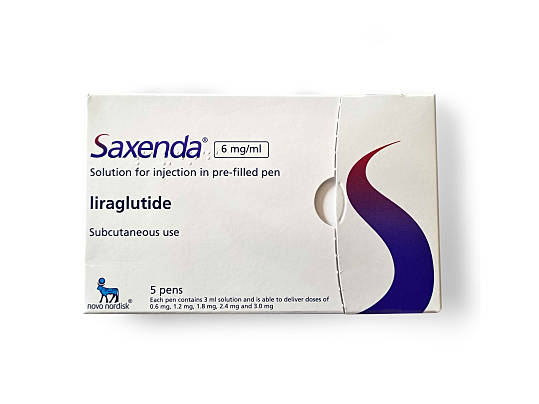Ozempic/Semaglutide for weight loss

Medically reviewed by
Dr Crystal WyllieLast reviewed: 14 Aug 2023
Ozempic is a prescription-only injection treatment for type 2 diabetes. The active ingredient in Ozempic is semaglutide. Ozempic can also help with weight loss (off-license – this is when a Doctor prescribes a treatment for something it wasn't originally intended to do) and some other health conditions as well.

Getting Ozempic for weight loss
Ozempic is only licensed in Ireland for managing weight for people who have type 2 diabetes. This means that unless you have type 2 diabetes, it can only be prescribed off-license in Ireland for weight loss. If you want to lose weight but don’t have type 2 diabetes, there are other weight loss treatment options available, like Saxenda, Orlistat or Xenical.

No results found.
Please check your spelling or try another treatment name.
Where can you buy it?
If your doctor agrees to give you a prescription for Ozempic, either on or off license, you can get it filled at most pharmacies. Some online services may also let you order Ozempic online.
Prices for Ozempic will be different depending on how it’s prescribed to you. It’s available on the NHS for people with type 2 diabetes, so it can cost as little as the standard NHS prescription cost, or it can be free if you don’t pay for your prescriptions. But, if it’s offered as an off-license private prescription, you’ll need to pay full price.
Is there a generic version?
There is currently no generic version of Ozempic. Generic medications cost less than branded ones like Ozempic, but they’re only available once a patent for a branded medication has run out. The earliest a generic version of Ozempic will be available in Ireland is probably December 5th 2031.
How to use it
You should take your Ozempic once a week on the same day of the week if possible. You can use it any time of day, no matter when you’ve eaten.
Always use Ozempic as your doctor has advised you to. Also check the information leaflet that comes with your medication.
How to use an Ozempic pen
How to use Ozempic, step-by-step:
- Decide where to do your injection. The best places are the front of your thighs, the front of your waist, or on your upper arms.
- Check your pen is the right colour, pull off the cap, and check the liquid inside isn’t cloudy or coloured.
- Take a new needle out of its paper tab, push it into the pen, and turn until it’s on tight.
- Pull off the outer needle cap and put it aside to remove the needle later, then take off the inner cap and throw it straight away.
- The first time you use a new pen, check the flow by turning to the flow check symbol and press the dose button until it lines up with 0.
- Turn the dose selector until you’ve found your prescribed dose (see the click chart above).
- Insert the needle into your skin and press and hold the dose button until the dose counter reaches 0.
- Remove the needle from your skin, use the outer needle cap to remove the needle and throw them away, then put your pen cap back on.
The pen cap should always be kept on when the pen is not in use. For more in-depth advice on using your Ozempic see this patient information leaflet.
What happens if you take too much?
If you realise you’ve taken too much of your Ozempic, talk to a doctor as soon as possible. You might get side effects like feeling sick.
How long can you keep using it for?
Ozempic is safe to use long-term. Your doctor will let you know when you’re ready to come off your medication. Don’t stop using your medication without talking to your doctor, unless you have serious side effects. If you’re not sure whether you still need Ozempic, your doctor will be able to advise you.
Does it need refrigerating?
Ozempic needs to be refrigerated at 2℃ to 8℃. Once it’s been used for the first time, an Ozempic pen can be kept in or out of the fridge as long as it’s not warmer than 30℃. Make sure you don’t freeze your Ozempic, and don’t use any Ozempic pens that have expired.
Are there foods to avoid during treatment?
No foods will react badly with Ozempic, so nothing is off the table. But, a bad diet can make some of the side effects of Ozempic more likely. Also, a good diet is an important part of managing weight and blood sugar. So, we recommend:
- avoiding high sugar foods, even ones that are sold as healthy, like breakfast bars
- avoid sugary drinks
- avoid high fat foods as well
- avoid food that are calorie-dense, like big portions of carbohydrates and red meats
Can you drink alcohol with Ozempic?
Alcohol doesn’t react with Ozempic, but they can both lower your blood sugar so watch out for dizziness if you do drink on your treatment.
Excessive drinking can increase your risk of complications from diabetes so it’s a good idea to limit drinking anyway. Also, alcohol has a lot of calories and often leads to overeating so there are a lot of benefits to cutting down on alcohol when taking treatments like Ozempic.
How effective is Ozempic
How quickly can you see results?
- Around 2 to 3 weeks after starting treatment. You should start feeling fuller after your first 2 to 3 doses.
- Different people react differently to Ozempic, but you should definitely notice a difference by 6 weeks at the latest if Ozempic works for you.
Although you should start feeling fuller within a number of weeks, it can still take some time to notice a difference in your weight. A major study showing weight loss on Ozempic lasted 68 weeks, so it’s a good idea to expect at least 5% weight loss after just over a year of treatment.
Depending on what you’re using Ozempic for, if you don’t notice any difference after 6 or 8 weeks you can discuss whether to continue or whether to switch to another treatment with the help of your doctor.
How much weight can you lose with Ozempic?
Studies have shown that it’s an effective treatment for weight loss that works for more than 80% of people who use it, with nearly a third of users losing more than 20% extra weight than they would have without Ozempic.
In a 68-week study of Ozempic’s active ingredient semaglutide:
- 86% lost at least 5% weight
- 69% lost at least 10% weight
- 50% lost at least 15% weight
What are the reviews like?
Ozempic is rated:
Alternatives to Ozempic
Ozempic vs other medications
Here are some other medications that are also used for weight loss or diabetes:
For weight loss:
- Wegovy is another semaglutide injection medication which is approved for treating weight loss in people who don’t have diabetes as well. This product is not available yet in Ireland, but should be coming soon. Once it’s ready, we’re hoping to offer it at ZAVA.
- Saxenda is another similar medication for reducing appetite that uses a similar but slightly different ingredient called liraglutide.
For Diabetes:
- Rybelsus is a tablet form of semaglutide which works in a similar way to the injections, but like Ozempic it’s only for people with diabetes.
- Metformin tablets are another kind of diabetes treatment that works by lowering your blood sugar levels.
- Trulicity is similar to Metformin but comes as an injection instead or a tablet
- Insulin is the hormone your body makes to manage blood sugar itself, but it’s also available as a diabetic medication as well.
If you’re looking to lose weight with medications similar to Ozempic and you don’t have diabetes, you could consider Wegovy or Saxenda.
Other weight loss medications that work slightly differently to Ozempic include branded Xenical and generic Orlistat.

No results found.
Please check your spelling or try another treatment name.
Other Ozempic alternatives
For some people, managing weight loss and controlling blood sugar can be done without medication. Instead, it can be done through:
- diet
- exercise
- weight loss programmes
Even if you are using medication, lifestyle changes like the ones listed above can help improve the effectiveness of your weight loss and blood sugar treatment.
Further information about Ozempic in general
How it works
For diabetes, Ozempic stops your blood sugar spiking. The semaglutide in Ozempic works the same way as the natural hormones your body releases after you’ve eaten to control your blood sugar levels.
For weight loss, the semaglutide in Ozempic can also make you more full from less food. It slows down how fast food travels through your body, making you feel fuller for longer. As you're less hungry, it’s easier to stick to a diet without overeating, helping you lose weight.
Available dosages
There are 4 doses of Ozempic used for treating diabetes. You start on the lowest and dose and then move up to higher doses during the start of your treatment:
For both weight loss and blood sugar:
- The first dose you’ll start on is 0.25mg for four weeks
- Then you’ll move up to 0.5mg after 4 weeks
Then for blood sugar only:
- If your blood sugar isn’t controlled at 0.5mg your doctor may move you up to 1mg
- If your blood sugar still isn’t controlled at 1mg your doctor may move you up again to 2mg
For weight loss:
- You’ll can be moved up to 1mg after 8 weeks
- You can move up again to 2mg but only if a doctor agrees it’s necessary for your weight loss goals
Possible side effects
Ozempic can cause side effects like any medication. Most of these side effects are mild but there is a risk of some serious ones too.
Signs of serious side effects and what to do
Serious side effects of Ozempic can include:
- complications of diabetic eye disease
- inflamed pancreas
- severe allergic reaction
See a doctor straight away if you get:
- eye problems or changes to your sight
- severe pain in your stomach and back that doesn’t go away
- breathing problems, swelling in your face, lips, tongue or throat and difficulty swallowing, or a fast heartbeat
Other side effects
Very common side effects that affect more than 10% of users:
- feeling sick
- diarrhea
Common side effects that affect up to 10% of users:
- throwing up
- low blood sugar
- gallstones
Uncommon side effects that affect up to 1% of users:
- change in how food tastes
- a fast pulse
- reactions where you use your injection, like bruises or irritation
- allergic reactions, like hives or a rash
How long do side effects last?
Some side effects like bloating go away after a few weeks, but some will stay as long as you’re taking Ozempic. If you stop Ozempic, these side effects will usually stop once all the Ozempic leaves your system, which takes about 5 weeks.
Frequently asked questions
Does Ozempic make you tired?
Yes, Ozempic can make you tired. Up to 10% of people who use Ozempic with other diabetes medications get low blood sugar, which can also make you tired. A doctor can help you manage side effects of low blood sugar.
Why is it so expensive?
Ozempic is a branded medication, which means only the manufacturer that holds the patent can make it. This means they can set the price for the treatment as well. Once a patent expires, generic versions of Ozempic can be made and sold cheaper. This won’t happen until December 2031.
What drugs can’t you take with Ozempic?
It’s important to tell your doctor if you’re using warfarin or insulin before you start using Ozempic. You should also tell your prescribing doctor about any other prescriptions or herbal treatments you’re using.
Ozempic is not known to interact with cannabis, but if you’re using weed or any other drugs recreationally, your doctor will need to know to make sure your treatment is safe.
Why am I gaining weight on Ozempic?
Ozempic can cause bloating in the first few weeks of use, but it doesn’t usually cause weight gain as a side effect. In fact it normally helps people lose weight. If you’re concerned about your weight, talk to your doctor. It could be that your weight gain is not related to your Ozempic treatment.
How long has Ozempic been on the market?
Ozempic was launched in Ireland on 2nd January 2019 for treating diabetes. It is still not licensed for weight loss in people without diabetes.
Will Ozempic get rid of belly fat?
Yes, but not more than anywhere else on your body. Your body burns fat evenly across your body as you lose weight. Some people are prone to storing more fat around their bellies than others. As Ozempic helps you lose weight, some of the fat from around your belly will be removed. There is no way of targeting a part of the body for removing fat without surgeries like liposuction.
Can a non-diabetic take Ozempic for weight loss?
Ozempic is only licensed for people with diabetes in Ireland. It can be prescribed off-label for weight loss if a doctor approves it. Wegovy, another medication with the same active ingredient, will be available in Ireland soon for treating weight loss in people with or without diabetes.
Do you gain weight back after stopping Ozempic?
It is possible to gain back weight after stopping Ozempic. Once you stop Ozempic, your appetite will return to normal. This means you need to keep your diet and exercise routine up or you will be at risk of overeating and gaining back the weight.
How many doses are in an Ozempic pen?
Each pen is only meant to deliver 4 doses. As your dosage increases from 0.25mg, to 0.5mg, to 1mg, and 2mg, the amount of medication in each pen also goes up:
- The 1mg pen contains 4 doses of 0.25mg
- The 2mg pen contains 4 doses of 0.5mg
- The 4mg pen contains 4 doses of 1mg
- The 8mg pen contains 4 doses of 2mg
Which is better Saxenda or Ozempic?
Medications work differently for different people, but studies show Ozempic is more effective than Saxenda overall.
People on Ozempic have a:
- 86% chance of losing at least 5% weight
- 71% chance of losing at least 10% weight
- 56% chance of losing at least 15% weight
- 39% chance of losing at least 20% weight
People on Saxenda have a:
- 56% chance of losing at least 5% weight
- 26% chance of losing at least 10% weight
- 12% chance of losing at least 15% weight
- 6% chance of losing at least 20% weight

Crystal qualified in Medicine at Barts and the London School of Medicine and Dentistry in 2010. She then trained as a GP in London hospitals and practices. She has a particular interest in reproductive, sexual and women’s health.
Meet our doctorsArticle created: 14 Aug 2023
Last reviewed: 14 Aug 2023
-
https://www.drugpatentwatch.com/p/generic-api/SEMAGLUTIDE [accessed April 23]
-
https://www.medicines.org.uk/emc/files/pil.9748.pdf [accessed April 23]
-
https://www.nicerx.com/blog/ozempic-foods-to-avoid/ [accessed April 23]
-
https://pubmed.ncbi.nlm.nih.gov/33567185/ [accessed April 23]
-
https://www.ncbi.nlm.nih.gov/pmc/articles/PMC5358074/ [accessed April 23]




IMC-Number: 429637

IMC-Number: 425122







